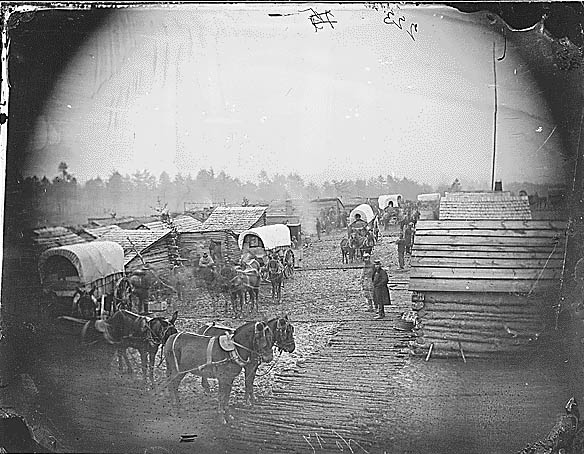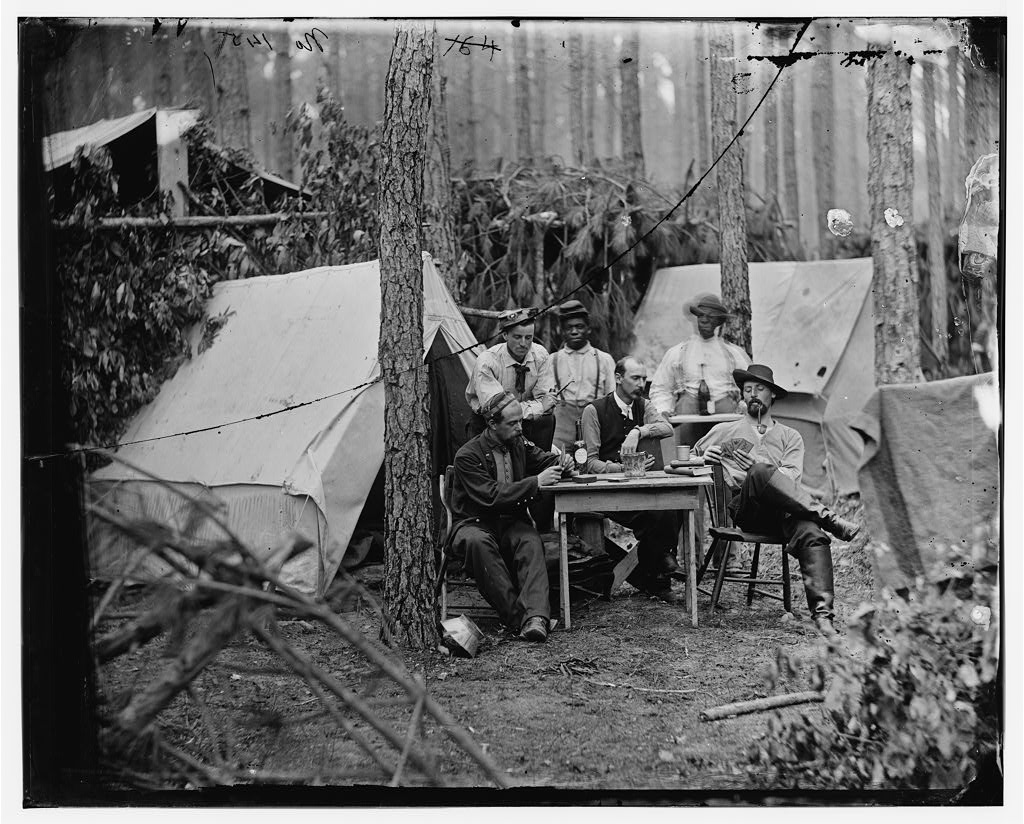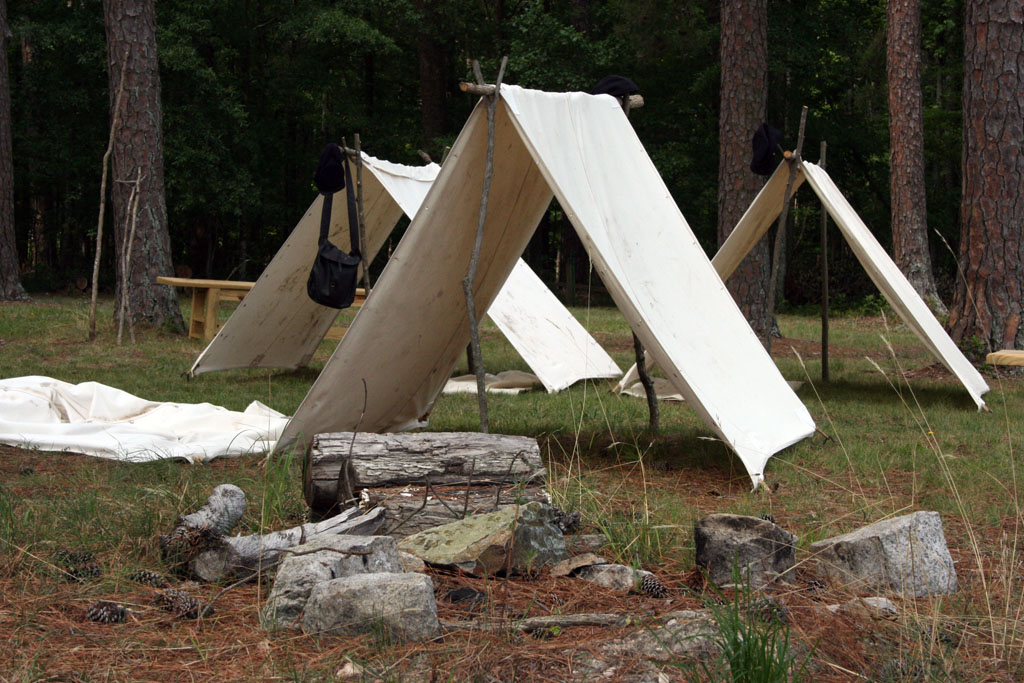The life of a soldier in the 1860s was an arduous one, and for the thousands of young Americans who left home to fight for their cause, it was an experience none of them would ever forget. Military service meant many months away from home and loved ones, long hours of drill, often inadequate food or shelter, disease, and many days spent marching on hot, dusty roads or in a driving rainstorm burdened with everything a man needed to be a soldier as well as baggage enough to make his life as comfortable as possible. There were long stretches of boredom in camp interspersed with moments of sheer terror experienced on the battlefield. For these civilians turned soldiers, it was very difficult at first getting used to the rigors and demands of army life. Most had been farmers all of their lives and were indifferent to the need to obey orders. Discipline was first and foremost a difficult concept to understand, especially in the beginning when the officer one had to salute may have been the hometown postmaster only a few weeks before. Uniforms issued in both armies were not quite as fancy as those worn by the hometown militias, and soldiering did not always mean fighting. There were fatigue duties such as assignments to gather wood for cook fires. Metal fittings had to be polished, horses groomed and watered, fields had to be cleared for parades and drill, and there were water details for the cook house. Guard duty meant long hours pacing up and down a well-trod line, day or night, rain or shine, always on watch for a foe who might be lurking anywhere in the hostile countryside. A furlough was hard to come by as every man was needed in the field and few men ever had a chance to visit home.
Summer and Winter Quarters
A soldier's home in camp was a rectangular piece of canvas buttoned to another to form a small two-man tent or dog tent as the soldiers called them. First introduced in 1862, every Union soldier was issued one for use during active campaign and the men joked that only a dog could crawl under it and stay dry from the rain. The tent could be easily pitched for the evening by tying each end to a rifle stuck in the ground by the bayonet or by stringing it up to fence rails. Confederates did not receive shelter tents though some Confederate units were issued a variation of the tent, which they pitched as a lean-to or shelter. As the war progressed it was very common for a Confederate camp to be filled with captured Union tents as well as captured blankets, canteens, and haversacks. Confederates especially prized the Union rubber blankets, which were not manufactured in the south and were ideal as a ground cloth or overhead shelter.
Army camps were like a huge bustling city of white canvas, sometimes obscured by smoke from hundreds of campfires. Camps were considered temporary throughout the year until the winter months when the armies would establish winter quarters. The soldiers would construct log huts that were large enough to accommodate several men, made of trees taken from any nearby source. The logs were laid out on stones underneath the bottom log, in a rectangle and notched to fit tight at the corners and stones, brick, or mud-covered logs were formed into a small fireplace in one end. Mud filled the gap between the logs and inside of the chimney over the fireplace. A roof made from tents or sawn boards and wooded bunks built inside finished the hut. Soldiers often named their winter huts after well known hotels or restaurants back home such as "Wiltshire Hotel" or "Madigan's Oyster House." The armies quartered in these small huts through the winter months and then it was back to the field and dog tents.
Drill and Discipline
The singular purpose of the soldier was to fight a battle and win. There were a variety of small arms used during the Civil War. The average infantryman carried a muzzle-loading rifle-musket manufactured in American arsenals or one purchased from foreign countries such as England. The bayonet was an important part of the rifle and its steel presence on the muzzle of the weapon was very imposing. When not in battle, the bayonet was a handy candle holder and useful in grinding coffee beans. The typical rifle-musket weighed eight and one-half pounds and fired a conical shaped bullet called the Minie Ball. Bullets were made of very soft lead and caused horrible wounds which were difficult to heal. The artillery was composed of both rifled and smoothbore cannon, each gun served by a crew of fourteen men including the drivers. The role of the artillery was to support the infantry while the infantry role was to either attack or defend, depending on the circumstances. Both branches worked together to coordinate their tactics on the field of battle. Cavalrymen were armed with breech loading carbines, sabers, and pistols. Cavalry was initially used for scouting purposes and to guard supply trains. The role of mounted troops had expanded by the time of Gettysburg, with cavalry divisions acting as skirmishers and fighting mounted and on foot in pitched battles such as Brandy Station, Virginia on June 9, 1863. Other branches of the armies included the signal corps, engineers, medical and hospital corps, as well as supply organizations including the quartermasters.
Marching and fighting drill was part of the daily routine for the Civil War soldier. Infantry soldiers drilled as squads and in company formations, each man getting accustomed to orders and formations such as marching in column and in a "company front," how to face properly, dress the line, and interact with his fellow soldiers. After an hour of drill on that level, the company moved onto regimental level drills and parades. The soldier practiced guard mount and other procedures such as the Manual of Arms, which infantrymen learned for the rifle-musket. Veterans of the war often remarked how they could recite the steps of loading and priming for many years after the war, thanks to the continual drill.The drill was important for the infantry for they used tactics that had changed little since the time of the American Revolution or the age of Napoleon: infantry fought in closely knit formations of two ranks (or rows) of soldiers, each man in the rank standing side by side. This formation was first devised when the single-shot, muzzle loading musket became the normal weapon on the battlefield, the close ranks being a necessity because of the limitations of the musket. Yet, by 1861, new technology had made the old fashioned smoothbore musket nearly obsolete with the introduction of the rifle musket. By the time of the Gettysburg Campaign, the rifle musket made up the majority of infantry weapons in both the Union and Confederate armies though it took much longer for the tactics to change. Even with the advance of the rifle musket, the weapons were still muzzle loaders and officers believed that the old-fashioned drill formations were still useful to insure a massing of continuous firepower that the individual soldier could not sustain. The result of this slow change was a much higher than anticipated rate of casualties on the battlefield.
Cavalrymen drilled with their sabers, both on foot and horseback, while artillerymen drilled with their cannons limbered up to the team of horses and unlimbered, ready to fire. Oddly enough, marksmanship on a rifle range did not take precedence over other drill the soldiers learned for several reasons -- the military believed that each man would shoot accurately when told to and the war departments did not wish to waste ammunition fired on random targets.
For the infantry, drums were used to announce daily activities, from sunrise to sunset. Reveille was sounded to begin the day at 5 AM, followed by an assembly for morning roll call and breakfast call. Sick call was sounded soon after breakfast, followed by assemblies for guard duty, drill, or to begin the march. Drummers were also important on the march to keep soldiers in step during parades and to call them to attention. In battle, drums were sometimes used to signal maneuvers and give signals for the ranks to load and fire their weapons. The artillery and cavalry relied solely on buglers who were as important in their roles as the drummers were to the infantry. When not playing for their respective regiments, musicians were often combined with regimental or brigade bands to play marching tunes or provide field music for parades, inspections, and reviews.
Discipline in the military was very strict. The Provost Marshal of the army was responsible for enforcing military rules, but regimental commanders also had the authority to dole out punishments for minor offenses. Petty offenses such as shirking camp duty or not keeping equipment in good order were usually treated with extra duties such as digging latrines, chopping wood, or standing extra hours on guard duty. Insubordination, thievery, cowardice, or other offenses were more serious and the guilty party was usually subjected to embarrassing punishments such as carrying a log, standing on a barrel, or wearing a placard announcing his crime. "Bucking and gagging" was also a common punishment -- the soldier's limbs were bound and he was gagged so he could not speak. In the artillery, the guilty person might be tied to the spare wheel on the back of a caisson. Desertion, spying, treachery, murder, or threats on an officer's life were the most serious offenses to which the perpetrator was condemned to military prison or shot by a firing squad. Crimes committed against civilians were also punishable by the army and felons were executed by hanging before a formation of soldiers.
Camp Life
Leisure activities were similar in either army and most of it was spent writing letters home. Soldiers were prolific letter writers and wrote at every opportunity. It was the only way for them to communicate with loved ones and inform the home folks of their condition and where they were. Thrifty soldiers sent their pay home to support their families and kept only a small amount to see them through until the next payday. The arrival of mail in camp was a cause for celebration no matter where the soldiers were and there was sincere grumbling when the mail arrived late. The lucky soldiers who received a letter from home often read and re-read them many times. Packages from home contained baked goods, new socks or shirts, underwear, and often soap, towels, combs, and toothbrushes. Union soldiers often spent their free time at the sutler's store, comparable to the modern post exchange, where they could purchase toiletries, canned fruit, pocketknives, and other supplementary items, but usually at exorbitant prices. A private's salary amounted to $13.00 per month in 1863 and those unfortunates who owed the sutler watched as most of their pay was handed over to the greedy businessman on pay day. Confederates did not have the luxury of sutlers, who disappeared soon after the war began. Instead they depended on the generosity of folks at home or farmers and businessmen near the camps.
Free time was also spent in card games, reading, pitching horseshoes, or team sports such as the fledgling sport of baseball, a game which rapidly gained favor among northern troops. Rule booklets were widely distributed and the game soon became a favorite. Soldiers also played a form of football that appeared more like a huge brawl than the game we know today, and often resulted in broken noses and fractured limbs. Holidays were celebrated in camp with feasts, foot races, horse racing, music, boxing matches, and other contests. But while on active campaign, the soldiers were limited to writing, cleaning uniforms and equipment, and sleeping.
Despite orders to the contrary, many soldiers kept pets with them including dogs, cats, squirrels, raccoons, and other wildlife. One regiment from Wisconsin even had a pet eagle that was carried on its own perch next to the regimental flags. General Lee was purported to have had a pet chicken that faithfully delivered a fresh egg for the general everyday. By far the most popular pets appears to have been dogs and their presence with a master in camp or on the march was often overlooked by high commanders. Many officers, including General George Armstrong Custer who kept a number of dogs around his headquarters, favored the hardiness of these loyal companions and their companionship was, as one soldier put it, a "soothing connection" with home. Both the 11th Pennsylvania Infantry and the 1st Maryland Infantry (CSA) had singular dogs that followed the men through the most difficult campaigns including Gettysburg. Sallie, the 11th Pennsylvania's unofficial mascot, is remembered in a bronze likeness on the regimental monument at Gettysburg and symoblized there for its loyalty to the dead of the regiment. The canine that accompanied the 1st Maryland was regrettably killed in action on July 3 at Culp's Hill, after having participated in the charge of the regiment. Struck by the animal's gallantry and loyalty to its human companions, a Union officer ordered that the animal be given a proper burial alongside the dead of 1st Maryland.
Religion was very important in the soldier's daily routine. Many of the men attended church services on a regular basis and some even carried small testaments with the rest of their baggage. Union and Confederate armies had numerous regimental and brigade chaplains. These loyal officers also acted as assistants in field hospitals comforting the sick and wounded, and writing letters home for those who could not write. Chaplains held field services for their respective units and most accompanied the soldiers as they marched onto the battlefield. Father William Corby, the chaplain of the Irish Brigade, is best remembered for his granting of unconditional absolution to the members of the brigade before they marched into battle in the Wheatfield on July 2nd. Father Corby was immensely popular with the men and in the post-war era became president of Notre Dame University.



